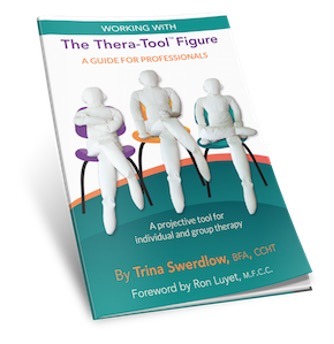An Effective Method For Children Suffering From Bullying – Guest Blog
Applying Technology Integrated Multimodal Play Therapy, Part 3/3
Leslie Baker, MFT, NCC, RPT-S

Continued from blog post #2
The client is asked to develop the bullying story that they had portrayed and to act it out with the Thera-Tool™ Figure and other props. The therapist can witness and/or participate depending on the client’s choice and may suggest video recording the drama play especially if the clinician is a part of the drama play so they can watch it as a playback to explore the experience from the 3rd person perspective.
Technology Integrated Multimodal Play Therapy creates an opportunity for a client to calm and downregulate as they explore their bullying incident, in the beginning, from the most structured moderate exposure, drawing it on a tablet. Overtime, the client exposes themselves with self-regulation, support and witnessing to two additional opportunities for more prolonged exposure to the same bullying incident. The Virtual Sandtray App and Drama Play allow the client to gain mastery and control over their world, affecting their vision of their traumatic experience. This process aids the client to develop outcomes they choose, and they decide on. The therapist provides the relationship and technology and becomes another trusted ally in their healing.
Helpful Tips:
- Be mindful to keep the clinical tablet you use free of personal information and be cautious to delete creations after printing them for your clients file.
- Video would only be appropriate with a properly signed consent form from the youth, parents and/or client and ability to manage digital assets with proper HIPPA regulations.
- If a client becomes flooded or dissociated while exploring the trauma material, stop the intervention and offer the MUSE for downregulating as needed or offer another downregulating opportunity such as bilateral tapping.
References
Gantt, L. & Tinnin, M.D., (2009). Support for a neurobiological view of trauma with implications for art therapy. The Arts in Psychotherapy. 36(3) 148-153. https://doi.org/10.1016/j.aip.2008.12.005
Hinduja, S. & Patchin, J.W., (2018) Connecting Adolescent Suicide to the Severity of Bullying and Cyberbullying, Journal of School Violence, DOI: 10.1080/15388220.2018.1492417 Abstract Retrieved from https://www.tandfonline.com/doi/full/10.1080/15388220.2018.1492417?scroll=top&needAccess=true
Perry, B.D., (2009). Examining child maltreatment through a neurodevelopmental lens: clinical application of the Neurosequential Model of Therapeutics. Journal of Loss and Trauma 14: 240-255.
Pierce, L., (2014). The Integrative power of Dance and Movement therapy: Implications for the Treatment of dissociation and developmental trauma. Arts in Psychotherapy, 41(1): 7-15. Retrieved From: https://doi.org/10.1016/j.aip.2013.10.002
The National Academies of Sciences, (2018) Preventing Bullying Through Science, Policy, and Practice Retrieved from https://www.nap.edu/read/23482/chapter/2
Van der Kolk B., (2014). The body keeps the score: Brain, mind, and body in the healing of trauma. New York, NY: Sage.
Leslie Baker, MFT, NCC, RPT-S: Licensed since 1991, Leslie serves couples, families, women, men and youth who are dealing with challenges in connecting to themselves, others and to their lives. Her specialties include: depression, anxiety, trauma, grief, loss and parenting issues; and she assists couples, individuals and families facing all types of life’s transitions and challenges. She provide safe and supportive, compassionate, results-oriented sessions to help reduce symptoms, increase resilience and options and facilitate well-being and happiness.
https://gottmanreferralnetwork.com/therapists/leslie-baker
Medibang paint: https://medibangpaint.com/en/
Virtual Sandtray: http://www.sandtrayplay.com
Thera-tool: https://www.trinaswerdlow.com/thera-tool-figure/